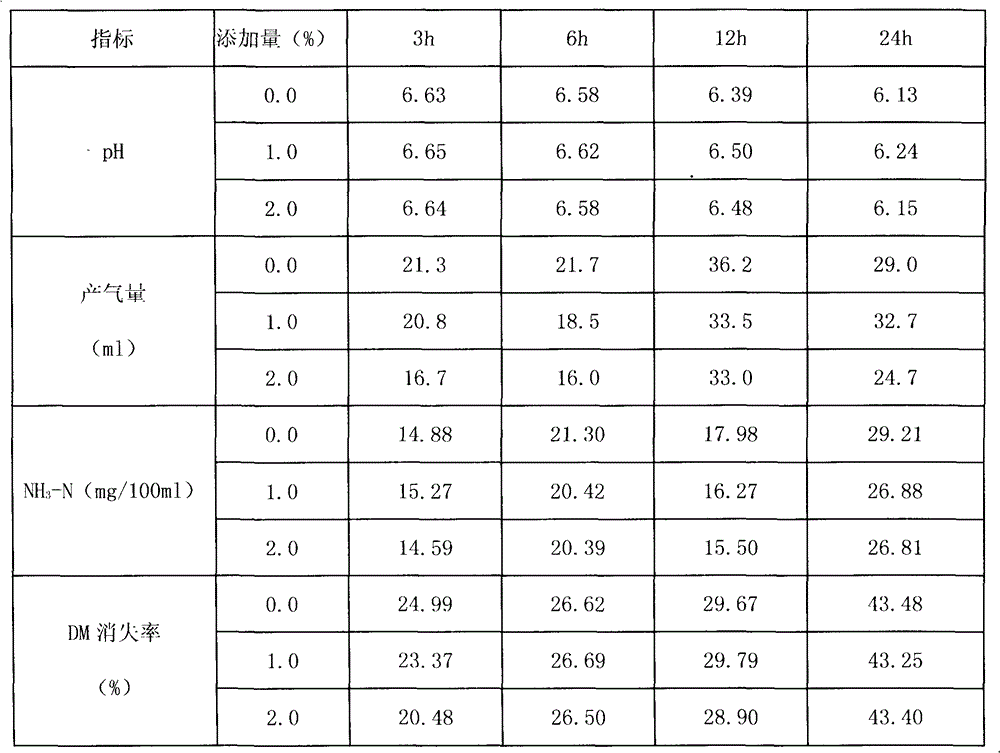Additive for reducing methane release of ruminant rumen
A technology for ruminants and additives, applied in animal feed, animal feed, drug combination, etc., can solve problems such as reducing feed digestibility
- Summary
- Abstract
- Description
- Claims
- Application Information
AI Technical Summary
Problems solved by technology
Method used
Image
Examples
Embodiment 1
[0038] The effects of additives on methane, rumen fermentation environment and cellulolytic bacteria in vitro and in vivo were tested.
[0039] According to the test, 200mg containing 70% hay, 18% corn, 6.5% soybean cake, 2.5% cottonseed cake, 2% premix, 1% salt are uniformly ground and mixed through a 40-mesh analytical sieve, and then added to the fermentation bottle . The above-mentioned feed mixing bottles were respectively added with the additives in the preferred ratio of the present invention in triplicate.
[0040] Three sheep were fed the ground feed and 500ml of coarsely filtered rumen fluids were mixed with 1000ml of buffer (colemans simplex). The buffer has the following composition:
[0041] colemans simplex buffer
[0042]a Trace element solution: CaCl2.2H2O 13.2g, MnCl2.4H2O 10.0g, CoCl2.6H2O 1.0g, FeCl3.6H2O 8.0g were dissolved in distilled water, cooled, and adjusted to 100ml.
[0043] b buffer solution: NaHCO3 35.0g, NH4HCO3 4.0g, dissolved in distilled w...
Embodiment 2
[0062] The addition of 1.5% of the additive extract of the preferred formulation of the present invention used in Implementation 1 is blended in the feed and fed to sheep on the impact of methane production, rumen internal environment indicators and the number of cellulolytic bacteria. Select 12 Karakul sheep about 1.5 years old and weighing about 30 and divide them into 2 groups randomly. Experimental animals were kept in well-ventilated metabolic cages, single cages, equipped with automatic drinking devices. Feed at 5:30 in the morning and 5:30 in the afternoon, drink water freely throughout the day, record the feed intake and leftover feed amount of the experimental sheep every day, and take samples to determine the dry matter intake. According to the SF6 tracer technique of Johnson et al. (1994), the amount of methane production was measured, and the rumen fluid was collected to measure the environmental indicators in the rumen and the number of cellulolytic bacteria. The...
PUM
 Login to View More
Login to View More Abstract
Description
Claims
Application Information
 Login to View More
Login to View More - Generate Ideas
- Intellectual Property
- Life Sciences
- Materials
- Tech Scout
- Unparalleled Data Quality
- Higher Quality Content
- 60% Fewer Hallucinations
Browse by: Latest US Patents, China's latest patents, Technical Efficacy Thesaurus, Application Domain, Technology Topic, Popular Technical Reports.
© 2025 PatSnap. All rights reserved.Legal|Privacy policy|Modern Slavery Act Transparency Statement|Sitemap|About US| Contact US: help@patsnap.com



